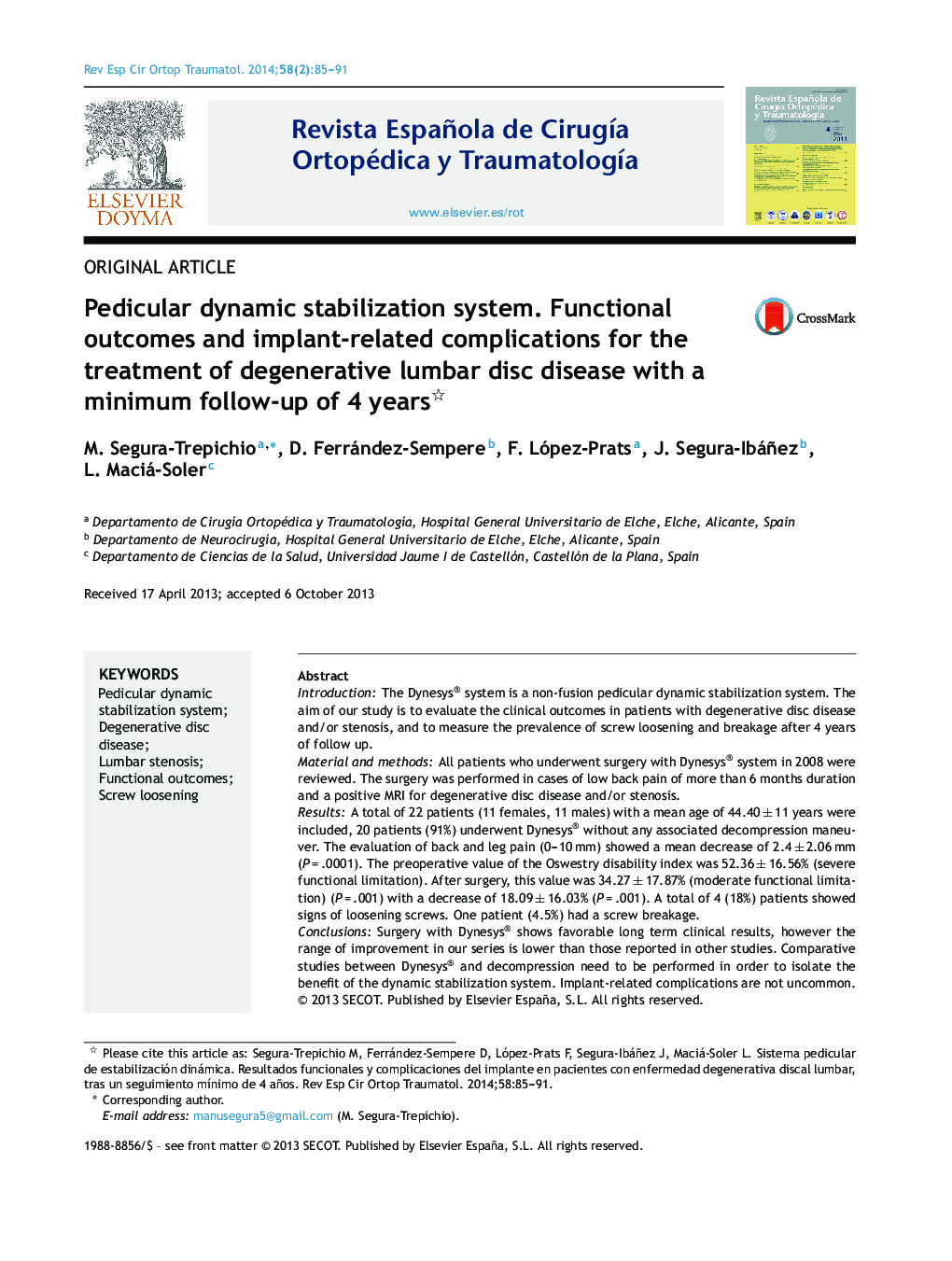| کد مقاله | کد نشریه | سال انتشار | مقاله انگلیسی | نسخه تمام متن |
|---|---|---|---|---|
| 4087276 | 1268027 | 2014 | 7 صفحه PDF | دانلود رایگان |
IntroductionThe Dynesys® system is a non-fusion pedicular dynamic stabilization system. The aim of our study is to evaluate the clinical outcomes in patients with degenerative disc disease and/or stenosis, and to measure the prevalence of screw loosening and breakage after 4 years of follow up.Material and methodsAll patients who underwent surgery with Dynesys® system in 2008 were reviewed. The surgery was performed in cases of low back pain of more than 6 months duration and a positive MRI for degenerative disc disease and/or stenosis.ResultsA total of 22 patients (11 females, 11 males) with a mean age of 44.40 ± 11 years were included, 20 patients (91%) underwent Dynesys® without any associated decompression maneuver. The evaluation of back and leg pain (0–10 mm) showed a mean decrease of 2.4 ± 2.06 mm (P = .0001). The preoperative value of the Oswestry disability index was 52.36 ± 16.56% (severe functional limitation). After surgery, this value was 34.27 ± 17.87% (moderate functional limitation) (P = .001) with a decrease of 18.09 ± 16.03% (P = .001). A total of 4 (18%) patients showed signs of loosening screws. One patient (4.5%) had a screw breakage.ConclusionsSurgery with Dynesys® shows favorable long term clinical results, however the range of improvement in our series is lower than those reported in other studies. Comparative studies between Dynesys® and decompression need to be performed in order to isolate the benefit of the dynamic stabilization system. Implant-related complications are not uncommon.
ResumenIntroducciónEl sistema de estabilización Dynesys® es un sistema pedicular de estabilización dinámica sin fusión. El objetivo de nuestro estudio es evaluar los resultados clínicos en pacientes con enfermedad degenerativa discal y/o estenosis, así como medir la prevalencia de aflojamiento de tornillos tras 4 años de seguimiento.Material y métodosSe trata de un estudio de serie de casos retrospectivo donde fueron incluidos todos los pacientes intervenidos desde enero a diciembre de 2008 con Dynesys®. Se indicó la cirugía si presentaban dolor lumbar de más de 6 meses de evolución y una RM positiva para enfermedad degenerativa discal y/o estenosis.ResultadosVeintidós pacientes (11 mujeres y 11 varones) con una edad media de 44,40 ± 11 años fueron evaluados. Veinte pacientes (91%) recibieron el implante Dynesys® sin ninguna maniobra de descompresión asociada. La evaluación del dolor de espalda y piernas (0–10 mm) registró una disminución media de 2,4 ± 2,06 mm (p = 0,0001). El valor preoperatorio del índice de discapacidad de Oswestry fue de 52,36 ± 16,56% (limitación funcional severa). Tras la cirugía este valor fue de 34,27 ± 17,87% (limitación funcional moderada) con una disminución de 18,09 ± 16,03% (p = 0,001). Cuatro pacientes (18%) mostraron signos de aflojamiento de tornillos. Un paciente (4,5%) presentó rotura de tornillo.ConclusionesLa cirugía con Dynesys® muestra resultados clínicos favorables, sin embargo el rango de mejoría en nuestra serie es menor a los comunicados por otros autores. Estudios comparativos entre Dynesys® y descompresión deberían realizarse para poder aislar el beneficio de la estabilización dinámica del obtenido por la descompresión. Las complicaciones relacionadas con el implante no son infrecuentes.
Journal: Revista Española de Cirugía Ortopédica y Traumatología (English Edition) - Volume 58, Issue 2, March–April 2014, Pages 85–91
